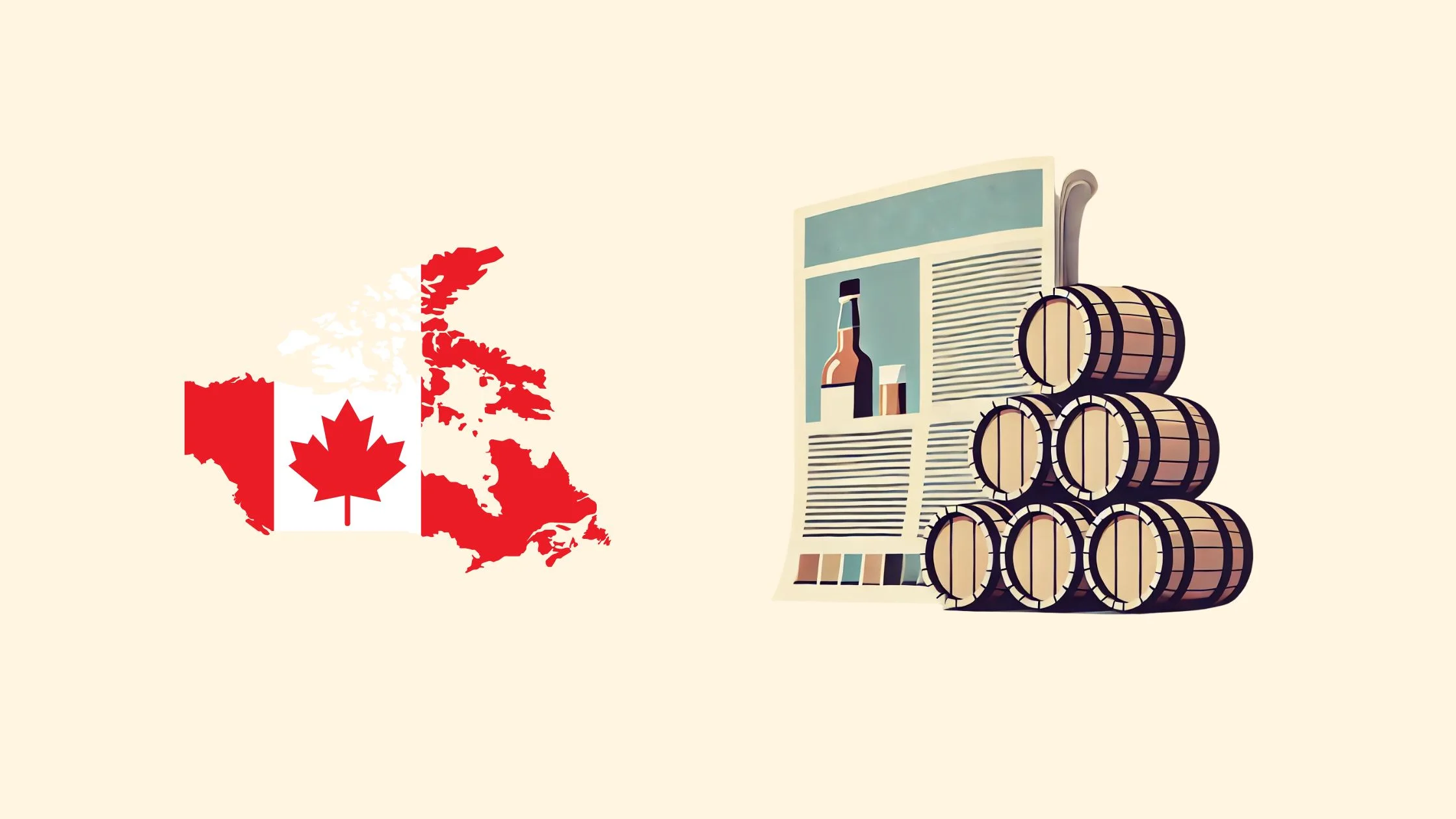Canadian whisky holds a unique position in the world of spirits with its rich, smooth flavor profile and versatile character. This distinctive nature sets Canadian whisky apart, creating a standalone category that offers a special experience for those exploring the diverse landscape of whisky. At the heart of Canadian whisky are key types such as Rye Whisky, known for its bold, spicy notes, and Corn Whisky, which offers a sweeter, smoother taste.
These varieties, along with blends that combine the nuanced flavors of different grains, contribute to the broad spectrum of tastes found in Canadian whisky. Historic whisky distilleries in Canada are testaments to the country’s long-standing tradition of whisky production, dating back to the 1800s. These distilleries are not just production facilities but are landmarks of Canadian heritage, embodying centuries of craftsmanship, innovation, and community spirit.
They serve as living museums, offering insight into the evolution of whisky distillation in Canada, from the early days of Scottish and Irish immigrant influences to the sophisticated operations of today. These historic sites preserve the legacy of Canadian whisky, showcasing the methods, styles, and flavors that have defined Canada’s contribution to the world of whisky.
How did whisky distillation start in Canada?
Whisky distillation in Canada began in the 1800s, introduced by Scottish and Irish immigrants seeking to recreate the cherished spirits of their homelands. These pioneers brought with them the knowledge and traditions of whisky making, adapting their techniques to the new world’s resources and conditions. This cross-cultural blend of distillation practices laid the foundation for what would become a flourishing whisky industry, characterized by innovation and a distinct Canadian identity.
Over time, Canadian distillers developed unique styles and flavors, contributing to the global tapestry of whisky.
Brought by Scottish and Irish immigrants in the 1800s.
The tradition of whisky distillation in Canada was initiated by Scottish and Irish immigrants during the 1800s. These early settlers imported their ancestral skills and knowledge of whisky making, adapting them to the Canadian landscape and its resources. This melding of traditions and techniques marked the beginning of Canada’s distinctive whisky industry.
The first distillery established by these immigrants was the Molson Distillery in Montreal in 1799, which began producing whisky alongside its beer. These immigrants introduced the pot still distillation method, a technique crucial for creating the rich, full-bodied flavors characteristic of early Canadian whisky.
Key historic whisky distilleries in Canada
Canada’s whisky heritage is embodied in its historic distilleries, each with a story that contributes to the rich tapestry of the nation’s spirits industry. Notable among these are Gooderham & Worts, established in 1837 in Toronto, marking one of the earliest chapters in Canadian whisky production. Hiram Walker & Sons, founded in 1858 in Windsor, is renowned for creating the iconic Canadian Club brand.
Corby Spirit and Wine, with origins dating back to 1859, has played a significant role in shaping the Canadian whisky landscape. These distilleries not only reflect the pioneering spirit of their founders but also the evolution of whisky making in Canada, from rudimentary operations to sophisticated enterprises that continue to innovate while honoring tradition.
Gooderham & Worts, established in 1837 in Toronto.
One of the earliest pioneers in Canadian whisky, Gooderham & Worts set the stage for the industry in Toronto, marking a significant chapter in the country’s distillation history.
Hiram Walker & Sons, founded in 1858 in Windsor.
Hiram Walker & Sons is renowned for its creation of the Canadian Club brand, a name synonymous with quality Canadian whisky, originating from Windsor.
Corby Spirit and Wine, origins dating back to 1859.
Corby Spirit and Wine has played a pivotal role in the development of the Canadian whisky scene, with a legacy that traces back to the mid-19th century.
Types of whisky from historic distilleries
Historic distilleries in Canada have been instrumental in defining the types of whisky that symbolize the nation’s spirit industry. Among these, Rye whisky stands out for its spicy, fruity flavor profile, a hallmark of Canadian whisky that distinguishes it on the global stage. Corn whisky, on the other hand, offers a smoother and sweeter taste, appealing to a wide range of palates.
These types, alongside blends that incorporate various grains, showcase the diversity and richness of Canadian whisky. Crafted with traditional methods and often aged in unique environments, the whiskies from these historic distilleries embody the essence of Canada’s natural beauty and the ingenuity of its people. To illustrate the excellence and variety of whisky produced by these historic distilleries, the following table includes specific whiskies that have won awards or have been recognized for their quality:
| Whisky Type | Distillery | Award-Winning Products | Notes | Awards/Recognitions |
|---|---|---|---|---|
| Rye Whisky | Hiram Walker & Sons | Lot No. 40 | Known for its bold, spicy flavor with a hint of fruitiness. | Multiple Canadian Whisky Awards, including “Canadian Whisky of the Year” |
| Corn Whisky | Gooderham & Worts | Gooderham & Worts Four Grain | A smooth, sweet whisky that blends the flavors of four different grains. | Gold Medal at the San Francisco World Spirits Competition |
| Blend | Corby Spirit and Wine | Pike Creek 10 Year Old Rum Barrel Finished | A unique blend aged in rum barrels to add complexity and sweetness. | Awarded “Best New Whisky” and several medals at international competitions |
Rye whisky, known for its spicy, fruity flavor.
Rye whisky is celebrated for its bold, spicy and fruity notes, making it a distinctive and cherished type of Canadian whisky. Distilleries like Hiram Walker & Sons have been recognized for their exceptional rye whiskies, such as Lot No. 40, which has received acclaim both nationally and internationally.
Corn whisky, typically smoother and sweeter.
Corn whisky offers a smoother and sweeter palate, showcasing a versatile profile that appeals to a broad audience. Gooderham & Worts’ Four Grain is an example of a corn-based whisky that has been awarded for its quality and complexity. This detailed table and the accompanying descriptions provide a clearer picture of the types of whisky produced by Canada’s historic distilleries, highlighting their contributions to the global whisky landscape through award-winning products.
Maintaining heritage in distilleries
Maintaining heritage in distilleries is a crucial aspect of preserving Canada’s whisky legacy. This involves conserving the architectural integrity of historic buildings, like the original Gooderham & Worts structure, and adhering to traditional distillation methods, such as using pot stills. By doing so, distilleries keep the spirit of the past alive, allowing visitors to step back in time and experience whisky production as it was centuries ago.
Recent restoration projects, such as the meticulous refurbishment of the Gooderham & Worts distillery to its 19th-century condition, showcase the dedication to preserving these historic sites. Similarly, the Hiram Walker & Sons distillery has maintained its use of traditional copper pot stills, a testament to the enduring legacy of Canadian whisky craftsmanship. These efforts ensure that the rich history of Canadian whisky continues to be celebrated by future generations, blending the past with the present in every sip.
Preserving buildings like the original Gooderham & Worts structure.
Preserving the architectural heritage of buildings, such as the iconic Gooderham & Worts distillery, is essential for maintaining the historical integrity and character of Canada’s whisky legacy. Efforts to restore these buildings to their original glory, using period-accurate materials and techniques, underscore the commitment to heritage conservation.
Using traditional distillation methods, such as pot stills.
Adhering to traditional distillation methods, including the use of pot stills, is key to preserving the authenticity and quality of Canadian whisky, honoring centuries-old craftsmanship. The continued use of these methods, alongside modern techniques, ensures that the spirit of historical distillation practices remains alive and well in the production of Canadian whisky today.
Challenges for historic distilleries
Historic distilleries in Canada face the dual challenge of modernizing operations while preserving their historical character. As they strive to meet contemporary production standards and consumer expectations, these distilleries must also safeguard the heritage that defines their identity. Additionally, competition from global and craft whisky producers puts pressure on these historic entities to innovate and differentiate their offerings without compromising their legacy.
Balancing these demands requires a careful blend of tradition and innovation, ensuring that the essence of Canada’s whisky heritage is maintained for future generations.
Modernizing while preserving historical character.
Historic distilleries are tasked with the complex challenge of updating their facilities and practices to meet modern standards, all while maintaining the unique historical essence that distinguishes them.
Competition from global and craft whisky producers.
Facing intense competition, historic distilleries must navigate a crowded market dominated by both large-scale global brands and innovative craft producers, compelling them to continually adapt and evolve.
Challenges and Strategies for Historic Distilleries
| Challenge | Distillery Example | Strategy Employed | Outcome |
|---|---|---|---|
| Modernizing Operations | Gooderham & Worts | Implemented advanced aging techniques while preserving traditional methods | Enhanced production efficiency without compromising quality |
| Preserving Historical Character | Hiram Walker & Sons | Restored historic buildings and maintained original distillation equipment | Successfully merged historical appeal with modern functionality |
| Adapting to Environmental Regulations | Corby Spirit and Wine | Adopted sustainable practices, such as waste reduction and energy efficiency | Reduced environmental impact and improved community relations |
| Incorporating New Technology | Gooderham & Worts | Integrated digital tracking for barrel aging process | Improved product consistency and traceability |
| Competition from Global Brands | Hiram Walker & Sons | Focused on unique Canadian identity and heritage in marketing | Strengthened brand recognition and loyalty |
| Competition from Craft Producers | Corby Spirit and Wine | Launched small-batch, experimental whiskies | Attracted new customers and expanded market share |
This detailed table provides insights into the specific challenges faced by historic distilleries in Canada and the strategies they employed to overcome these obstacles. By modernizing operations, preserving historical character, adapting to environmental regulations, incorporating new technology, and addressing competition, these distilleries have managed to maintain their heritage while evolving to meet contemporary demands.
Reasons to visit historic distilleries
Visiting historic distilleries offers a unique opportunity to delve into Canada’s whisky heritage, blending education with sensory experience. These tours provide a firsthand look at the traditional distillation processes, from mashing to aging, allowing visitors to appreciate the craftsmanship involved in whisky production. Additionally, tastings feature traditional and limited-edition whiskies, offering a palate education that spans the history and innovation of Canadian whisky.
Beyond the spirits themselves, the architectural beauty and historical significance of the distilleries enrich the visit, making it a culturally immersive experience. This combination of learning, tasting, and exploration appeals to whisky enthusiasts and history buffs alike, making historic distilleries a must-visit destination.
Educational tours on the history of whisky in Canada.
Educational tours offer insights into the rich history of whisky production in Canada, highlighting the evolution of distillation techniques and the stories behind iconic brands. Visitors often express amazement at the depth of knowledge shared, with one guest noting, “The tour was enlightening; I had no idea of the intricate history and craftsmanship behind Canadian whisky.”
Tasting sessions featuring traditional and limited-edition whiskies.
Tasting sessions provide a unique opportunity to sample a range of whiskies, from time-honored classics to innovative, limited-edition releases, showcasing the diversity of Canada’s whisky heritage. Enthusiasts frequently rave about these experiences, with comments like, “The tasting session was a highlight for me. Sampling whiskies that I can’t find anywhere else was an unforgettable experience.” To enhance the appeal and informative nature of this section, incorporating visitor testimonials and highlighting unique experiences offered by these distilleries could significantly enrich the narrative.
Testimonials serve as powerful endorsements, adding a personal touch that can motivate others to visit. Additionally, detailing exclusive offerings like behind-the-scenes tours or the chance to sample rare whiskies directly from the cask could further illustrate the unique opportunities available at Canada’s historic distilleries, making the section more compelling and comprehensive.
Impact of historic distilleries on local communities
Historic distilleries significantly impact local communities, serving as catalysts for tourism and economic development. By attracting visitors from around the globe, these distilleries boost local economies, creating jobs and supporting small businesses. Furthermore, they play a crucial role in preserving local traditions and craftsmanship, ensuring that the rich history of whisky production is passed down through generations.
This symbiotic relationship between distilleries and their communities fosters a sense of pride and cultural identity, making these historic sites invaluable assets to their regions. For instance, the Hiram Walker & Sons distillery in Windsor has been instrumental in the local community’s development, contributing to both tourism and employment. Its visitor center and tours attract whisky enthusiasts and history buffs, providing a significant boost to the local hospitality and service industries.
Similarly, Gooderham & Worts in Toronto has played a key role in revitalizing the Distillery District, turning it into a vibrant cultural and commercial hub that celebrates the city’s industrial past while offering new economic opportunities.
Boosting tourism and local economy.
- Hiram Walker & Sons, Windsor: Major contributor to local tourism, drawing visitors to the area and supporting the hospitality sector.
- Gooderham & Worts, Toronto: Central to the revitalization of the Distillery District, enhancing the local economy through tourism and retail.
Preserving local traditions and craftsmanship.
- Corby Spirit and Wine: Offers workshops and apprenticeships in traditional distilling techniques, helping to preserve the craft for future generations and fostering a sense of community pride.
- Distillery Heritage Projects: Many historic distilleries participate in heritage projects, such as restoring old buildings and equipment, which serve as educational resources for the community and visitors, ensuring the continuation of local traditions.





